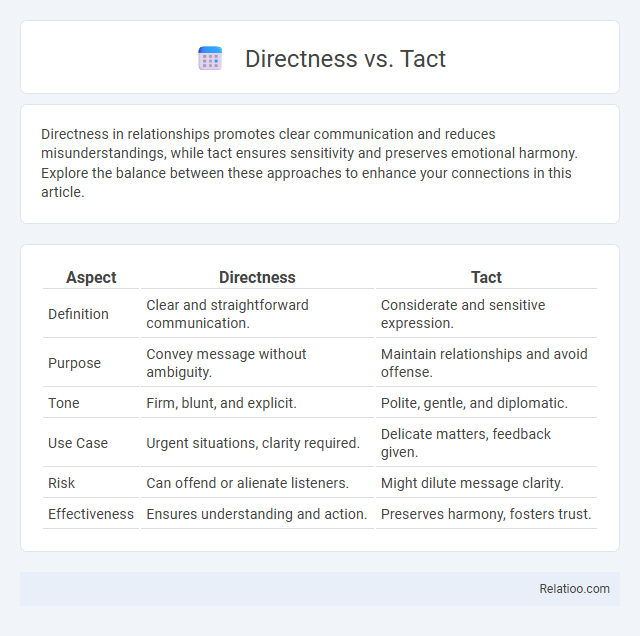Directness in relationships promotes clear communication and reduces misunderstandings, while tact ensures sensitivity and preserves emotional harmony. Explore the balance between these approaches to enhance your connections in this article.
Table of Comparison
| Aspect | Directness | Tact |
|---|---|---|
| Definition | Clear and straightforward communication. | Considerate and sensitive expression. |
| Purpose | Convey message without ambiguity. | Maintain relationships and avoid offense. |
| Tone | Firm, blunt, and explicit. | Polite, gentle, and diplomatic. |
| Use Case | Urgent situations, clarity required. | Delicate matters, feedback given. |
| Risk | Can offend or alienate listeners. | Might dilute message clarity. |
| Effectiveness | Ensures understanding and action. | Preserves harmony, fosters trust. |
Understanding Directness and Tact: Key Definitions
Directness involves communicating messages clearly and straightforwardly without ambiguity, prioritizing honesty and transparency in expression. Tact refers to delivering messages considerately, with sensitivity and respect, aiming to maintain harmony and avoid offense in interpersonal interactions. Understanding these concepts helps balance honesty with empathy, ensuring communication is both truthful and respectful.
The Cultural Influences on Communication Styles
Cultural influences significantly shape communication styles, determining preferences for directness, tact, or honest expression; for example, many Western cultures prioritize directness and clarity to convey honesty, while East Asian cultures value tact and indirectness to maintain harmony and avoid conflict. In high-context cultures, such as Japan or India, subtlety and non-verbal cues are essential for conveying meaning, emphasizing respect and saving face. Understanding these cultural nuances is critical for effective intercultural communication, as misinterpretations can arise when differing norms about honesty and expression clash.
Benefits of Direct Communication
Direct communication enhances clarity by eliminating ambiguity, allowing messages to be understood quickly and accurately. It fosters efficiency in decision-making and problem-solving within teams, reducing time wasted on misinterpretations. Transparent dialogue built on directness cultivates trust and accountability, strengthening professional and personal relationships.
Advantages of Tactful Communication
Tactful communication enhances interpersonal relationships by delivering honest feedback with sensitivity, which helps prevent misunderstandings and reduces conflicts. Your ability to express opinions thoughtfully promotes trust and respect, fostering a collaborative environment in both personal and professional contexts. Employing tact ensures clarity while maintaining empathy, leading to more effective and positive exchanges.
Common Misunderstandings: When Directness Feels Rude
Direct communication often gets mistaken for rudeness when the intention is simply to be clear and efficient. Your directness can be perceived as harsh or insensitive if the cultural or emotional context is overlooked, leading to misunderstandings about your tone or intent. Recognizing that tact involves balancing honesty with empathy helps avoid unnecessary conflict while maintaining meaningful and respectful expression.
Navigating Sensitive Topics: Choosing Tact Over Directness
Navigating sensitive topics requires you to balance directness with tact to maintain trust and understanding while avoiding unnecessary offense. Tactful communication involves carefully choosing your words and tone to express honesty without alienating your audience or escalating conflict. Prioritizing empathy and emotional intelligence when addressing delicate subjects ensures your message is both clear and considerate, fostering healthier interactions.
Workplace Scenarios: When to Be Direct or Diplomatic
In workplace scenarios, your choice between directness, tact, or honest expression depends on the context and audience sensitivity. Direct communication is effective for clear instructions and urgent issues, while tact helps maintain relationships during conflict resolution or feedback. Honest expression fosters trust but should be balanced with diplomacy to avoid misunderstandings.
Impacts on Relationships: Balancing Honesty and Sensitivity
Direct communication fosters clarity and trust but can sometimes risk offending others if not tempered with tact. Tactful expression prioritizes sensitivity, helping to preserve relationships by softening potentially hurtful truths while still conveying essential messages. Balancing honesty with kindness enhances interpersonal connections by maintaining transparency without compromising empathy, ultimately strengthening mutual respect and understanding.
Practical Tips to Develop Directness and Tact
Balancing directness and tact is essential for effective communication in both personal and professional settings. To develop your directness, practice clear and concise language while maintaining respect for the listener's feelings. Enhance your tact by actively listening, choosing words carefully, and considering the impact of your message to foster honest and constructive expression.
Striking the Right Balance: Mastering Effective Communication
Mastering effective communication requires striking the right balance between directness, tact, and honest expression to convey your message clearly without causing unnecessary offense. You can achieve this by tailoring your language to the context and audience while prioritizing empathy alongside transparency. This approach enhances understanding, builds trust, and fosters productive relationships in both personal and professional settings.

Infographic: Directness vs Tact
 relatioo.com
relatioo.com